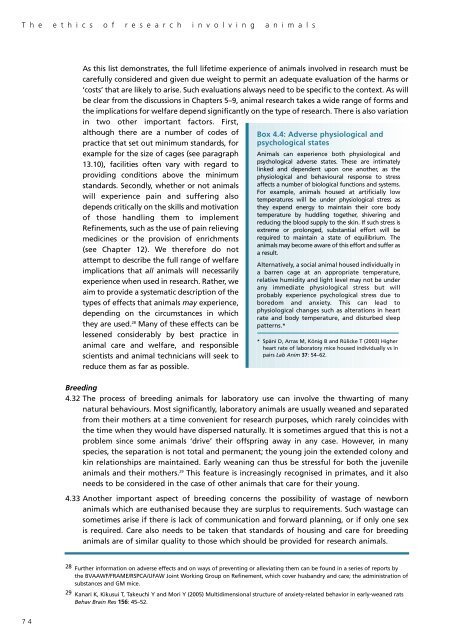The ethics of research involving animals - Nuffield Council on ...
The ethics of research involving animals - Nuffield Council on ...
The ethics of research involving animals - Nuffield Council on ...
Create successful ePaper yourself
Turn your PDF publications into a flip-book with our unique Google optimized e-Paper software.
T h e e t h i c s o f r e s e a r c h i n v o l v i n g a n i m a l s<br />
As this list dem<strong>on</strong>strates, the full lifetime experience <str<strong>on</strong>g>of</str<strong>on</strong>g> <str<strong>on</strong>g>animals</str<strong>on</strong>g> involved in <str<strong>on</strong>g>research</str<strong>on</strong>g> must be<br />
carefully c<strong>on</strong>sidered and given due weight to permit an adequate evaluati<strong>on</strong> <str<strong>on</strong>g>of</str<strong>on</strong>g> the harms or<br />
‘costs’ that are likely to arise. Such evaluati<strong>on</strong>s always need to be specific to the c<strong>on</strong>text. As will<br />
be clear from the discussi<strong>on</strong>s in Chapters 5–9, animal <str<strong>on</strong>g>research</str<strong>on</strong>g> takes a wide range <str<strong>on</strong>g>of</str<strong>on</strong>g> forms and<br />
the implicati<strong>on</strong>s for welfare depend significantly <strong>on</strong> the type <str<strong>on</strong>g>of</str<strong>on</strong>g> <str<strong>on</strong>g>research</str<strong>on</strong>g>. <str<strong>on</strong>g>The</str<strong>on</strong>g>re is also variati<strong>on</strong><br />
in two other important factors. First,<br />
although there are a number <str<strong>on</strong>g>of</str<strong>on</strong>g> codes <str<strong>on</strong>g>of</str<strong>on</strong>g><br />
practice that set out minimum standards, for<br />
example for the size <str<strong>on</strong>g>of</str<strong>on</strong>g> cages (see paragraph<br />
13.10), facilities <str<strong>on</strong>g>of</str<strong>on</strong>g>ten vary with regard to<br />
providing c<strong>on</strong>diti<strong>on</strong>s above the minimum<br />
standards. Sec<strong>on</strong>dly, whether or not <str<strong>on</strong>g>animals</str<strong>on</strong>g><br />
will experience pain and suffering also<br />
depends critically <strong>on</strong> the skills and motivati<strong>on</strong><br />
<str<strong>on</strong>g>of</str<strong>on</strong>g> those handling them to implement<br />
Refinements, such as the use <str<strong>on</strong>g>of</str<strong>on</strong>g> pain relieving<br />
medicines or the provisi<strong>on</strong> <str<strong>on</strong>g>of</str<strong>on</strong>g> enrichments<br />
(see Chapter 12). We therefore do not<br />
attempt to describe the full range <str<strong>on</strong>g>of</str<strong>on</strong>g> welfare<br />
implicati<strong>on</strong>s that all <str<strong>on</strong>g>animals</str<strong>on</strong>g> will necessarily<br />
experience when used in <str<strong>on</strong>g>research</str<strong>on</strong>g>. Rather, we<br />
aim to provide a systematic descripti<strong>on</strong> <str<strong>on</strong>g>of</str<strong>on</strong>g> the<br />
types <str<strong>on</strong>g>of</str<strong>on</strong>g> effects that <str<strong>on</strong>g>animals</str<strong>on</strong>g> may experience,<br />
depending <strong>on</strong> the circumstances in which<br />
they are used. 28 Many <str<strong>on</strong>g>of</str<strong>on</strong>g> these effects can be<br />
lessened c<strong>on</strong>siderably by best practice in<br />
animal care and welfare, and resp<strong>on</strong>sible<br />
scientists and animal technicians will seek to<br />
reduce them as far as possible.<br />
Box 4.4: Adverse physiological and<br />
psychological states<br />
Animals can experience both physiological and<br />
psychological adverse states. <str<strong>on</strong>g>The</str<strong>on</strong>g>se are intimately<br />
linked and dependent up<strong>on</strong> <strong>on</strong>e another, as the<br />
physiological and behavioural resp<strong>on</strong>se to stress<br />
affects a number <str<strong>on</strong>g>of</str<strong>on</strong>g> biological functi<strong>on</strong>s and systems.<br />
For example, <str<strong>on</strong>g>animals</str<strong>on</strong>g> housed at artificially low<br />
temperatures will be under physiological stress as<br />
they expend energy to maintain their core body<br />
temperature by huddling together, shivering and<br />
reducing the blood supply to the skin. If such stress is<br />
extreme or prol<strong>on</strong>ged, substantial effort will be<br />
required to maintain a state <str<strong>on</strong>g>of</str<strong>on</strong>g> equilibrium. <str<strong>on</strong>g>The</str<strong>on</strong>g><br />
<str<strong>on</strong>g>animals</str<strong>on</strong>g> may become aware <str<strong>on</strong>g>of</str<strong>on</strong>g> this effort and suffer as<br />
a result.<br />
Alternatively, a social animal housed individually in<br />
a barren cage at an appropriate temperature,<br />
relative humidity and light level may not be under<br />
any immediate physiological stress but will<br />
probably experience psychological stress due to<br />
boredom and anxiety. This can lead to<br />
physiological changes such as alterati<strong>on</strong>s in heart<br />
rate and body temperature, and disturbed sleep<br />
patterns.*<br />
* Späni D, Arras M, König B and Rülicke T (2003) Higher<br />
heart rate <str<strong>on</strong>g>of</str<strong>on</strong>g> laboratory mice housed individually vs in<br />
pairs Lab Anim 37: 54–62.<br />
Breeding<br />
4.32 <str<strong>on</strong>g>The</str<strong>on</strong>g> process <str<strong>on</strong>g>of</str<strong>on</strong>g> breeding <str<strong>on</strong>g>animals</str<strong>on</strong>g> for laboratory use can involve the thwarting <str<strong>on</strong>g>of</str<strong>on</strong>g> many<br />
natural behaviours. Most significantly, laboratory <str<strong>on</strong>g>animals</str<strong>on</strong>g> are usually weaned and separated<br />
from their mothers at a time c<strong>on</strong>venient for <str<strong>on</strong>g>research</str<strong>on</strong>g> purposes, which rarely coincides with<br />
the time when they would have dispersed naturally. It is sometimes argued that this is not a<br />
problem since some <str<strong>on</strong>g>animals</str<strong>on</strong>g> ‘drive’ their <str<strong>on</strong>g>of</str<strong>on</strong>g>fspring away in any case. However, in many<br />
species, the separati<strong>on</strong> is not total and permanent; the young join the extended col<strong>on</strong>y and<br />
kin relati<strong>on</strong>ships are maintained. Early weaning can thus be stressful for both the juvenile<br />
<str<strong>on</strong>g>animals</str<strong>on</strong>g> and their mothers. 29 This feature is increasingly recognised in primates, and it also<br />
needs to be c<strong>on</strong>sidered in the case <str<strong>on</strong>g>of</str<strong>on</strong>g> other <str<strong>on</strong>g>animals</str<strong>on</strong>g> that care for their young.<br />
4.33 Another important aspect <str<strong>on</strong>g>of</str<strong>on</strong>g> breeding c<strong>on</strong>cerns the possibility <str<strong>on</strong>g>of</str<strong>on</strong>g> wastage <str<strong>on</strong>g>of</str<strong>on</strong>g> newborn<br />
<str<strong>on</strong>g>animals</str<strong>on</strong>g> which are euthanised because they are surplus to requirements. Such wastage can<br />
sometimes arise if there is lack <str<strong>on</strong>g>of</str<strong>on</strong>g> communicati<strong>on</strong> and forward planning, or if <strong>on</strong>ly <strong>on</strong>e sex<br />
is required. Care also needs to be taken that standards <str<strong>on</strong>g>of</str<strong>on</strong>g> housing and care for breeding<br />
<str<strong>on</strong>g>animals</str<strong>on</strong>g> are <str<strong>on</strong>g>of</str<strong>on</strong>g> similar quality to those which should be provided for <str<strong>on</strong>g>research</str<strong>on</strong>g> <str<strong>on</strong>g>animals</str<strong>on</strong>g>.<br />
28 Further informati<strong>on</strong> <strong>on</strong> adverse effects and <strong>on</strong> ways <str<strong>on</strong>g>of</str<strong>on</strong>g> preventing or alleviating them can be found in a series <str<strong>on</strong>g>of</str<strong>on</strong>g> reports by<br />
the BVAAWF/FRAME/RSPCA/UFAW Joint Working Group <strong>on</strong> Refinement, which cover husbandry and care; the administrati<strong>on</strong> <str<strong>on</strong>g>of</str<strong>on</strong>g><br />
substances and GM mice.<br />
29 Kanari K, Kikusui T, Takeuchi Y and Mori Y (2005) Multidimensi<strong>on</strong>al structure <str<strong>on</strong>g>of</str<strong>on</strong>g> anxiety-related behavior in early-weaned rats<br />
Behav Brain Res 156: 45–52.<br />
74
















